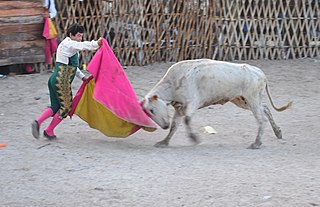
A bullfighter is a performer in the activity of bullfighting. Torero or toureiro, both from Latin taurarius, are the Spanish and Portuguese words for bullfighter and describe all the performers in the activity of bullfighting as practised in Spain, Portugal, Mexico, Peru, France, Colombia, Ecuador, Venezuela and other countries influenced by Portuguese and Spanish culture. The main performer and leader of the entourage in a bullfight, and who finally kills the bull, is addressed as maestro (master), or with the formal title matador de toros. The other bullfighters in the entourage are called subalternos and their suits are embroidered in silver as opposed to the matador's gold. They include the picadores, rejoneadores, and banderilleros.

Juan Belmonte García was a Spanish bullfighter. He fought in a record number of bull fights and was responsible for changing the art of bullfighting. He had minor deformities in his legs which forced him to design new techniques and styles of bullfighting.

A bullring is an arena where bullfighting is performed. Bullrings are often associated with the Iberian Peninsula, but they can also be found through Iberian America and in a few Spanish and Portuguese ex-colonies in Africa. Bullrings are often historic and culturally significant centres that bear many structural similarities to the Roman amphitheatre.

Francisco Romero (1700–1763) was a significant Spanish matador. He reputedly introduced the famous red cape (muleta) into bullfighting in around 1726.
José Carlos Frita Falcão, known as José Falcón was a Portuguese matador whose bullfighting career spanned just over a decade. As of 2011, he was the last matador to be killed in the ring.
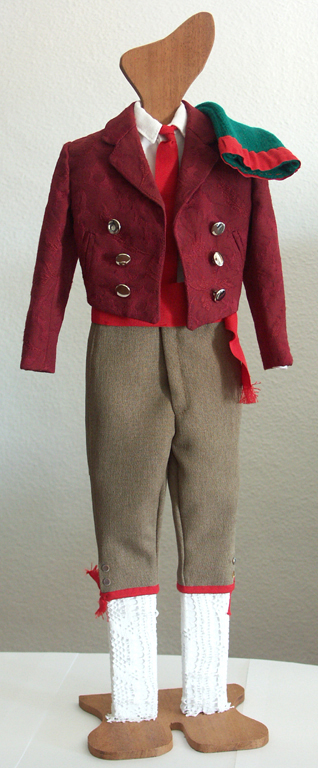
A forcado is a member of a group of men that performs the pega de cara or pega de caras, the final event in a typical Portuguese bullfight. The only Spanish-style bullfighting where forcados may also be present are Mexican bullfights. Forcados were initially professionals from lower classes but nowadays people from all social backgrounds practice their art through amateur groups.

The Spanish Fighting Bull is an Iberian heterogeneous cattle population. It is exclusively bred free-range on extensive estates in Spain, Portugal, France and Latin American countries where bull fighting is organized. Fighting bulls are selected primarily for a certain combination of aggression, energy, strength and stamina. In order to preserve their natural traits, during breeding the bulls rarely encounter humans, and if so, never encounter them on foot.

Agro-Velho, historically and popularly known as Nova Póvoa, is one of the eleven officially designated districts located in the Portuguese city of Póvoa de Varzim. It is a beach resort district located around Lagoa Cove.

Concepción Cintrón Verrill, also known as Conchita Cintrón or La Diosa de Oro, was a Chile-born Peruvian torera, perhaps the most famous in the history of bullfighting. In the ring Cintrón was said to display particular grace, style and bravado, a combination known as duende.

The Campo Pequeno Bullring is the current Praça de Touros of the city of Lisbon, in Portugal. It is located in Avenida da República, in Lisbon.

El Fandi is statistically one of the most skilled matadors in the world. Currently, he is ranked number one among all bullfighters in Spain.

Spanish-style bullfighting is a type of bullfighting that is practiced in Spain, Mexico, Colombia, Ecuador, Venezuela, Peru, as well as in parts of southern France and Portugal. This style of bullfighting involves a physical contest with humans attempting to publicly subdue, immobilize, or kill a bull. The most common bull used is the Spanish Fighting Bull, a type of cattle native to the Iberian Peninsula. This style of bullfighting is seen to be both a sport and performance art. The red colour of the cape is a matter of tradition – bulls are color blind. They attack moving objects; the brightly-colored cape is used to mask blood stains.

Antonio Cayetano Rivera Ordóñez is a Spanish torero or 'bullfighter'.

Touro is a bronze sculpture in Póvoa de Varzim, Portugal. The monument is located in an intersection, a square also popularly known as Touro, at the junction of Vasco da Gama Avenue and Repatriamento dos Poveiros Avenue.

An anti-bullfighting city is a city that formally adheres to a declaration of ethics and adopts municipal policies that do not support the practice of bullfighting within their borders and state that they are against the practice of bullfighting altogether.
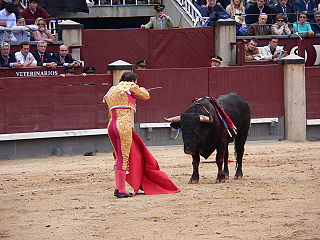
Bullfighting is a physical contest that involves a bullfighter attempting to subdue, immobilize, or kill a bull, usually according to a set of rules, guidelines, or cultural expectations.
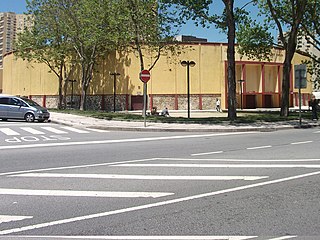
Póvoa de Varzim Bullfighting Arena was a bullring in Póvoa de Varzim, Portugal. It is located on Avenida Vasco da Gama, on the northern waterfront of the city. Bullfighting, horse shows, and concerts are held in the arena.
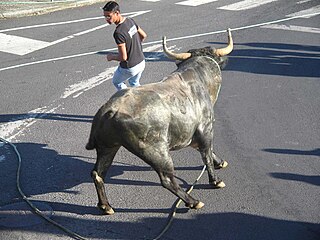
Tourada à corda, toirada à corda or corrida de touros à corda, is a type of bullfighting traditional to the Azores Islands, and particularly the island of Terceira, where it is believed to be one of the most ancient recreational traditions in the archipelago.

Juan José Padilla is a Spanish torero ('bullfighter'). He became a matador de toros, 'killer of (full-grown) bulls', in the town of his birth, Jerez de la Frontera, on June 18, 1994 when he was 21 years old. He was known as the 'Cyclone of Jerez' and featured heavily, both personally and professionally, in Into The Arena: The World Of The Spanish Bullfight, a shortlisted nominee for the William Hill Sports Book of the Year in 2011.

The Vila Franca de Xira Bullring, also known as the Palha Blanco Bullring is situated in the centre of the town of Vila Franca de Xira in the municipality of the same name in the Lisbon District of Portugal. It was built in 1901, is still used and is one of the eight “First Category” bullrings in the country.






















